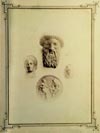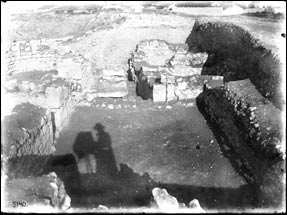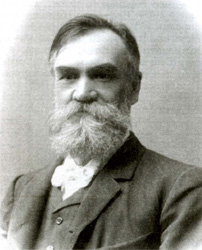|
PHOTOGRAPHY IN CHERSONESOS IN THE PERIOD WHEN THE EXCAVATIONS WERE CONDUCTED BY THE IMPERIAL ARCHAEOLOGICAL COMMISSION (1888 – 1914)
The Chair of the Imperial Archaeological Commission Count Aleksey Aleksandrovich Bobrinskiy highly appreciated scientific and technological achievements. He was one of the first persons in Russia who purchased daguerreotype camera by ordering it from Paris. When the Committee headed by him started systematic excavations in Tauric Chersonesos, photographers got in possession rather perfect cameras and lenses, technology of photo printing advanced, portrait, art and reportage photography developed. It was the time when about a dozen of periodicals concerning photography were published in Russia. Scholarly photography made considerable progress: cameras for underwater and aerial photography were invented, pictures of various natural phenomena and scientific experiments were published. This essay will trace the development of photography throughout the period on the concrete example of photographing archaeological excavations in the ancient city of Chersonesos.
First photographs. Photo artists of Sevastopol
It was 1888 when a respected dweller of Sevastopol, the member of the Odessa society for History and Antiquities Karl Kazimirovich Kostsyushko-Valyuzhinich was appointed the head of the works in Chersonesos. Being pedant par excellence, used to work with documents, Karl Kazimirovich accurately fixed the results of his excavations. He produced casts of inscriptions, or the so-called squeezes, drew the finds and made plans. Especially important drawings he ordered from professional draftsmen and painters, but it was not immediately that he organized photo fixation of the archaeological discoveries made by him.
 The first information of a photograph made for archaeological report dates from February 1889: according to payroll, an anonymous photographer received 6 roubles for two pictures of wax casts. These were casts of terracotta heads discovered in 1888 in the ancient sculptor’s workshop. The first information of a photograph made for archaeological report dates from February 1889: according to payroll, an anonymous photographer received 6 roubles for two pictures of wax casts. These were casts of terracotta heads discovered in 1888 in the ancient sculptor’s workshop.
A bit later in the same year, 10 roubles were paid to painter and photograph A. Lukhtergandt for a photo (only one?). Lukhtergandt’s photo studio was known in Sevastopol from 1889 to 1895. Later on, his studio passed to S. I. Raynish.
 It was the time when the distance between Chersonesos and Sevastopol was three versts (1 verst is 1,067 m), so photograph arrived and departed in cab. It was the time when the distance between Chersonesos and Sevastopol was three versts (1 verst is 1,067 m), so photograph arrived and departed in cab.
As we have still not found a portrait of Lukhtergandt, here we place a photograph that could be called “Unknown photographer of Chersonesos”. Let the shadow of the man inclining to his camera be a collective image of all those who photographed ancient ruins and did not leave their portraits to us.
 Another Sevastopol photographer and painter who established close cooperation with K. K. Kostsyushko-Valyuzhinich was famous Mikhail Nikolayevich Protopopov. His photographs embellished many Karl Kazimirovich’s reports, they were published in books issued by the Imperial Archaeological Commission. His “Crimean Photography” studio was located in house 18 of present-day Bolshaya Morskaya street. Biographical data of Mikhail Nikolayevich is collected in Ye. Chvertkin’s book Nezabytyy Sevastopol’ (Unforgotten Sevastopol), though his portrait for this resource we borrowed from Ye. Altabayeva’s and V. Kovalenko’s textbook Na rubezhe epokh: Sevastopol’ v 1905–1916 godakh (In the turn of epochs: Sevastopol in 1905–1916). Another Sevastopol photographer and painter who established close cooperation with K. K. Kostsyushko-Valyuzhinich was famous Mikhail Nikolayevich Protopopov. His photographs embellished many Karl Kazimirovich’s reports, they were published in books issued by the Imperial Archaeological Commission. His “Crimean Photography” studio was located in house 18 of present-day Bolshaya Morskaya street. Biographical data of Mikhail Nikolayevich is collected in Ye. Chvertkin’s book Nezabytyy Sevastopol’ (Unforgotten Sevastopol), though his portrait for this resource we borrowed from Ye. Altabayeva’s and V. Kovalenko’s textbook Na rubezhe epokh: Sevastopol’ v 1905–1916 godakh (In the turn of epochs: Sevastopol in 1905–1916).
M. N. Protopopov’s works for Chersonesos will be discussed in full details in the next chapter. Here we will mention his “colour” photographs of the most valuable finds: gold decorations and other jewelleries from rich burials from Roman Chersonesos. It was the time when experiments with colour photo prints just started, but widespread were black-and-white photographs coloured by hand. The technology of applying colour on image was as follows. Transparent paints were added by brush above still wet imprint. Many photo collections and private archives still store such pictures of children as rosy-cheeked angels and ladies in light-blue dresses. Being an excellent artist, Protopopov could easily reproduce natural colours of archaeological finds except for gold items. Here are some examples of such archaeological painted photos.
Besides those masters who were specially invited and delivered from Sevastopol in cabs, photographs of Chersonesos were also produced by scholars, many of whom had rather good skills in photography. It is known that A. L. Berthier Delagarde produced many photographical illustrations for the reports to the Imperial Archaeological Commission.
Here is the letter that K. K. Kostsyushko-Valyuzhinich received in April 1890 from famous specialist in Oriental Studies Ya. I. Smirnov:
Dear Karl Kazimirovich!
I must ask for your apologizes for so late a realization of my promise that is now very old. The reasons for such a delay are partly from our northern Cimmerian darkness* and “feathers that fill the sky”*, which greatly delay the process of making photo prints, and partly, to my shame, from our northern laziness, of which I am sorry to say. But now I finally have a pleasure to fulfil my promise.
I am sending the photographs to You and to the museum without sticking them to cardboard, partly because I have no idea how You will place them and partly, I am sorry, due to financial reasons in transportation.
If you need to stick them to carton, in order to save them of losing brightness, just stick them by corners, slightly smearing gum arabic on them. Please send to Pavel Lavrent’yevich two pictures with his family, unfortunately, of not enough quality, together with my compliments.
I must apologize that not all the imprints attached are of the same quality. Being engaged in photography for less than a year, I have not become fully proficient in the complicated operation of managing tints of prints, so that is why they appeared to be greenish.
Again, sorry for so late realization of my promise and I remain grateful to You for Your courtesy towards myself during my stay in Sevastopol. Wish You and Your family all the best.
Ready to serve you, Ya. Smirnov
The photographs attached to this and previous, 1889, report actually have greenish tint but we can not definitely state that they were taken by Yakov Ivanovich Smirnov or someone else.
To be continued...
|